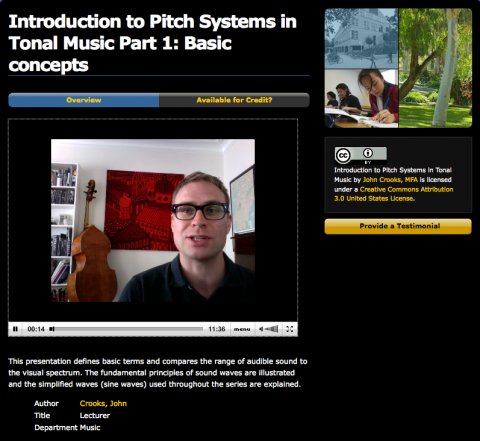Introduction to Pitch Systems in Tonal Music - Music 15ABC

Creative Commons License Introduction to Pitch by John Crooks is licensed under a Creative Commons Attribution-ShareAlike 3.0 United States License.
To view a lecture, click on any of the links below. By default, the video views in a smaller window. For bettter viewing, we recommend clicking on the player's "full screen" button located on the right side of the player controls.
This presentation defines basic terms and compares the range of audible sound to the visual spectrum. The fundamental principles of sound waves are illustrated and the simplified waves (sine waves) used throughout the series are explained.
Part 2: The Octave and Just Intervals
This presentation explains the octave, a 2:1 ratio of frequencies, and octave equivalence, the core concept in tonal systems. An oscilloscope is used to visualize various musical ratios including the perfect fifth and perfect fourth. The connection is made between musical intervals and simple whole number ratios.
Part 3: Octave equivalence, circular pitch systems, and the major triad
This presentation will expand the concept of octaves as a spectrum to incorporate the circle of fifths, a common diagram for study of music theory. Understanding the circle of fifths leads to a larger realization; tonal pitch systems are circular.
The 5:4 major third will be added to the set of simple number ratio intervals we've studied, 2:1, 3:2, and 4:3. This new interval will allow us to form a major triad and open a new avenue for exploration of tonal pitch systems.
Part 4: Circular pitch systems and the triad
This presentation will demonstrate how the 4:5:6 ratio known as a major triad works within the circular pitch system of tonal music. The concept of I, IV, and V (1, 4, and 5) harmonic functions will be explained using the basic mathematical structures already demonstrated.
Part 5: Building a diatonic set with 3 to 2 ratios
This presentation shows how 3:2 frequency ratios can be stacked to form a major scale (also known as a diatonic scale, diatonic collection, or diatonic set). Now we've progressed to the point of generating functional sets of frequencies--scales--using simple math and an understanding of how tonal pitch systems work. This kind of approach to creating a scale is known as Pythagorean tuning.
Part 6: Pythagorean tuning and the pure triad
This presentation explores how the major triads formed by the Pythagorean tuning system sound when compared with pure 4:5:6 major triads. The differences are subtle, but easy to hear and see using an oscilloscope, and begin to complicate the apparently simple system of using 3:2 and 4:5:6 ratios to form a tonal pitch system.
Part 7: The minor triad and a circular system of thirds
This presentation introduces the 6:5 minor third and 10:12:15 minor triad. The tonal pitch system uses major and minor triads, and the pitch system in use has to accommodate this. These sounds and ratios lead to the construction of a diatonic circle of thirds and a further goal; tune a diatonic set so that all I IV V major and i iv v minor triads are pure whole number ratios.
Part 8: Tuning with pure major and minor triads
This presentation shows an attempt to build a diatonic set where all major and minor triads are in tune. Like the Pythagorean diatonic set, this scale is almost but not quite perfectly functional. The Pythagorean scale's shortcomings were its out-of-tune triads and lack of complete circularity; this scale with pure triads has a gap between the major and minor triads called a comma.
Part 9: A 12-tone Pythagorean set
This presentation uses 3:2 ratios to create a 12-tone set very much like the twelve tone chromatic system in common use today. Despite its out-of-tune triads, this scale seems very functional but suffers from a gap in its frequencies, another comma, meaning it is not circular. Since the tonal pitch system relies on circularity (the ability to modulate from any key center to another without adjusting the tuning system), it becomes clear that although fifths and triads sound best when tuned to simple ratios some adjustment will have to be made to these pure ratios to make a truly circular pitch system.
Links:
- UCI
- OpenCourseWare
- My personal website
- Music MFA in Integrated Composition Improvisation and Technology
- UCI Music Department
Author: John Crooks
Title: Lecturer
Department: Music
Attribution
John Crooks
UCI has been nominated for various #OCW People’s Choice awards for Best user experience, Most open and Best OER (non-video) please Vote here.

This moving image, Introduction to Pitch Systems in Tonal Music - Music 15ABC, by John Crooks is licensed under a Creative Commons Attribution-ShareAlike 3.0 Unported license.

